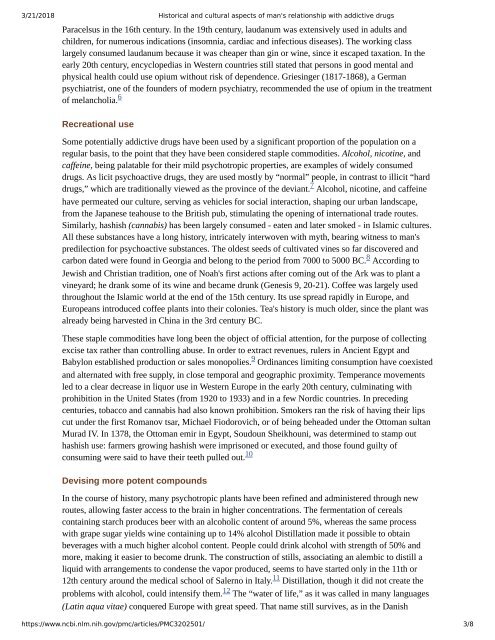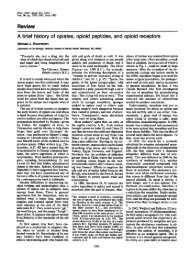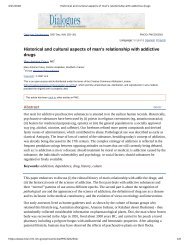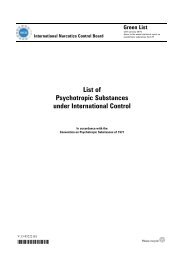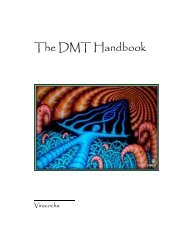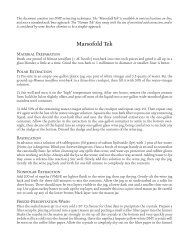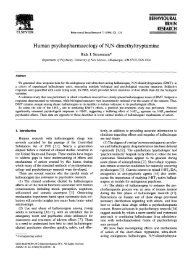Historical and cultural aspects of man's relationship with addictive drugs
Historical and cultural aspects of man's relationship with addictive drugs
Historical and cultural aspects of man's relationship with addictive drugs
Create successful ePaper yourself
Turn your PDF publications into a flip-book with our unique Google optimized e-Paper software.
3/21/2018 <strong>Historical</strong> <strong>and</strong> <strong>cultural</strong> <strong>aspects</strong> <strong>of</strong> <strong>man's</strong> <strong>relationship</strong> <strong>with</strong> <strong>addictive</strong> <strong>drugs</strong><br />
Paracelsus in the 16th century. In the 19th century, laudanum was extensively used in adults <strong>and</strong><br />
children, for numerous indications (insomnia, cardiac <strong>and</strong> infectious diseases). The working class<br />
largely consumed laudanum because it was cheaper than gin or wine, since it escaped taxation. In the<br />
early 20th century, encyclopedias in Western countries still stated that persons in good mental <strong>and</strong><br />
physical health could use opium <strong>with</strong>out risk <strong>of</strong> dependence. Griesinger (1817-1868), a German<br />
psychiatrist, one <strong>of</strong> the founders <strong>of</strong> modern psychiatry, recommended the use <strong>of</strong> opium in the treatment<br />
6<br />
<strong>of</strong> melancholia.<br />
Recreational use<br />
Some potentially <strong>addictive</strong> <strong>drugs</strong> have been used by a significant proportion <strong>of</strong> the population on a<br />
regular basis, to the point that they have been considered staple commodities. Alcohol, nicotine, <strong>and</strong><br />
caffeine, being palatable for their mild psychotropic properties, are examples <strong>of</strong> widely consumed<br />
<strong>drugs</strong>. As licit psychoactive <strong>drugs</strong>, they are used mostly by “normal” people, in contrast to illicit “hard<br />
7<br />
<strong>drugs</strong>,” which are traditionally viewed as the province <strong>of</strong> the deviant. Alcohol, nicotine, <strong>and</strong> caffeine<br />
have permeated our culture, serving as vehicles for social interaction, shaping our urban l<strong>and</strong>scape,<br />
from the Japanese teahouse to the British pub, stimulating the opening <strong>of</strong> international trade routes.<br />
Similarly, hashish (cannabis) has been largely consumed - eaten <strong>and</strong> later smoked - in Islamic cultures.<br />
All these substances have a long history, intricately interwoven <strong>with</strong> myth, bearing witness to <strong>man's</strong><br />
predilection for psychoactive substances. The oldest seeds <strong>of</strong> cultivated vines so far discovered <strong>and</strong><br />
8<br />
carbon dated were found in Georgia <strong>and</strong> belong to the period from 7000 to 5000 BC. According to<br />
Jewish <strong>and</strong> Christian tradition, one <strong>of</strong> Noah's first actions after coming out <strong>of</strong> the Ark was to plant a<br />
vineyard; he drank some <strong>of</strong> its wine <strong>and</strong> became drunk (Genesis 9, 20-21). C<strong>of</strong>fee was largely used<br />
throughout the Islamic world at the end <strong>of</strong> the 15th century. Its use spread rapidly in Europe, <strong>and</strong><br />
Europeans introduced c<strong>of</strong>fee plants into their colonies. Tea's history is much older, since the plant was<br />
already being harvested in China in the 3rd century BC.<br />
These staple commodities have long been the object <strong>of</strong> <strong>of</strong>ficial attention, for the purpose <strong>of</strong> collecting<br />
excise tax rather than controlling abuse. In order to extract revenues, rulers in Ancient Egypt <strong>and</strong><br />
9<br />
Babylon established production or sales monopolies. Ordinances limiting consumption have coexisted<br />
<strong>and</strong> alternated <strong>with</strong> free supply, in close temporal <strong>and</strong> geographic proximity. Temperance movements<br />
led to a clear decrease in liquor use in Western Europe in the early 20th century, culminating <strong>with</strong><br />
prohibition in the United States (from 1920 to 1933) <strong>and</strong> in a few Nordic countries. In preceding<br />
centuries, tobacco <strong>and</strong> cannabis had also known prohibition. Smokers ran the risk <strong>of</strong> having their lips<br />
cut under the first Romanov tsar, Michael Fiodorovich, or <strong>of</strong> being beheaded under the Ottoman sultan<br />
Murad IV. In 1378, the Ottoman emir in Egypt, Soudoun Sheikhouni, was determined to stamp out<br />
hashish use: farmers growing hashish were imprisoned or executed, <strong>and</strong> those found guilty <strong>of</strong><br />
10<br />
consuming were said to have their teeth pulled out.<br />
Devising more potent compounds<br />
In the course <strong>of</strong> history, many psychotropic plants have been refined <strong>and</strong> administered through new<br />
routes, allowing faster access to the brain in higher concentrations. The fermentation <strong>of</strong> cereals<br />
containing starch produces beer <strong>with</strong> an alcoholic content <strong>of</strong> around 5%, whereas the same process<br />
<strong>with</strong> grape sugar yields wine containing up to 14% alcohol Distillation made it possible to obtain<br />
beverages <strong>with</strong> a much higher alcohol content. People could drink alcohol <strong>with</strong> strength <strong>of</strong> 50% <strong>and</strong><br />
more, making it easier to become drunk. The construction <strong>of</strong> stills, associating an alembic to distill a<br />
liquid <strong>with</strong> arrangements to condense the vapor produced, seems to have started only in the 11th or<br />
12th century around the medical school <strong>of</strong> Salerno in Italy. 11 Distillation, though it did not create the<br />
problems <strong>with</strong> alcohol, could intensify them. 12 The “water <strong>of</strong> life,” as it was called in many languages<br />
(Latin aqua vitae) conquered Europe <strong>with</strong> great speed. That name still survives, as in the Danish<br />
https://www.ncbi.nlm.nih.gov/pmc/articles/PMC3202501/ 3/8


